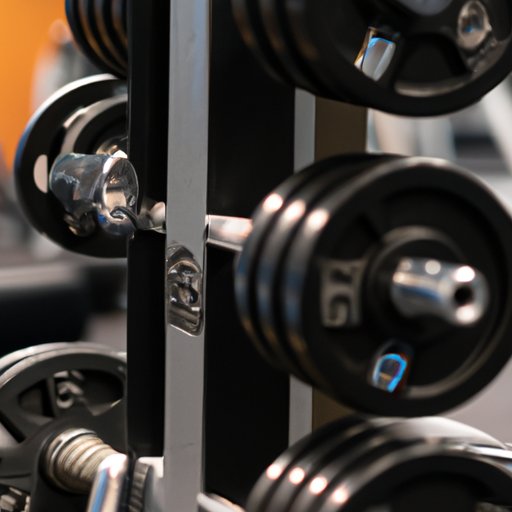
Introduction
Are free weights or machines better for building muscle and strength? This is a common question among gym-goers and fitness enthusiasts. In this article, we will weigh the pros and cons of both methods and help you determine which is best for you based on your personal fitness goals and preferences.
Pros and Cons: Weighing the Pros and Cons of Free Weights and Machines
Before delving into the specifics of each method, it’s important to understand the general advantages and disadvantages of both free weights and machines.
Advantages of free weights
Free weights provide a greater range of motion compared to machines. This range of motion allows for more muscle activation and development. Additionally, free weights develop greater balance and stability because the body’s stabilizing muscles are activated throughout the exercise. With free weights, each exercise activates more muscles compared to machines.
Disadvantages of free weights
Free weights require more experience to use properly and increase the risk of injury if used incorrectly. Free weights also take up more space to store and use compared to machines.
Advantages of machines
Machines are easier to use for beginners and offer more precise resistance control. Machines can also isolate individual muscles for targeted workouts.
Disadvantages of machines
Machines limit the range of motion and don’t activate as many muscles as free weights. Machines can also be more expensive than free weights.
Functionality: Exploring the Different Functionalities of Free Weights and Machines
There are various types of free weights and machines that can be used to build muscle and strength.
Free weights
Dumbbells, barbells, and kettlebells are all forms of free weights. Dumbbells are hand-held weights that come in various sizes and can be used for a variety of exercises. Barbells are long metal bars with weight plates that can be added or removed. Kettlebells are cast iron weights that are shaped like a ball with a handle on top.
Machines
Cable machines, weight stack machines, and plate-loaded machines are the most common types of weight machines. Cable machines use a cable and pulley system to provide resistance. Weight stack machines use a weight stack to provide resistance, and plate-loaded machines use weight plates that are loaded onto the machine.
Injury Risk: Examining the Injury Risk of Free Weights versus Machines
When it comes to injury risk, both free weights and machines have their own set of risks.
Injury risk associated with free weights
Improper form or technique and lack of experience can cause injury when using free weights. Additionally, heavy weight can cause strains or tears if used incorrectly.
Injury risk associated with machines
Overreliance on machines can cause muscle imbalances, and faulty equipment can cause injury. Repetitive motion injuries can occur with improper use of machines.
Muscles Worked: Comparing the Muscles Worked Using Free Weights and Machines
Free weights and machines target different muscle groups and activate different muscles.
Free weights
Free weights are great for full-body exercises and multi-joint exercises. Free weights engage stabilizing muscles and require greater balance and stability.
Machines
Machines are great for isolation exercises and targeting specific muscles. Machines have a limited range of motion and don’t activate as many muscles as free weights.

Personal Preference: Discussing the Personal Preference for Free Weights over Machines and Vice Versa
Personal preference can play a big role in choosing between free weights and machines.
Personal preference factors
Factors such as exercise environment, prior experience with equipment, and fitness goals and preferences can influence personal preference.
Examples of personal preference
Bodybuilders may prefer free weights for greater muscle activation, while circuit trainers may prefer machines for easier transitions between exercises.
Fitness Goals: Determining Which Method Is Best Based on Your Fitness Goals
Different fitness goals may require different methods of training.
Strength training goals
If your goal is to develop power and explosiveness or improve overall strength, then free weights may be the better option.
Muscle building goals
If your goal is to build muscle mass and definition or develop symmetrically balanced muscles, then both free weights and machines can be effective depending on the exercise.
Endurance and conditioning goals
If your goal is to increase cardiovascular endurance or develop muscular endurance, then machines may be the better option.
References: Using Scientific Research to Identify the Superior Method Between Free Weights and Machines
Scientific research has been conducted on the benefits and risks of both free weights and machines.
Overview of research on free weights versus machines
Overall, there is no clear winner between free weights and machines. Both methods have advantages and disadvantages, and the best method depends on personal preference and fitness goals.
Scientific studies on injury risk associated with free weights and machines
Studies have found that both free weights and machines can cause injury if used improperly. It’s important to use proper form and technique to prevent injury.
Studies on muscle activation and development with free weights and machines
Studies have found that both free weights and machines can activate and develop muscles effectively, but there may be differences depending on the exercise and muscle group.
Conclusion
Choosing between free weights and machines depends on personal preference and fitness goals. Both methods have advantages and disadvantages, and it’s important to use proper form and technique to prevent injury. Ultimately, the best method is the one that works best for you and helps you achieve your fitness goals.




